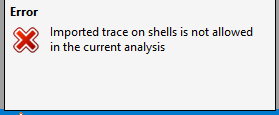TAGGED: pcb, shell, steady-state-thermal
-
-
October 7, 2022 at 5:27 am
agupta8
SubscriberFor steady state thermal case, I am trying to map the PCB tracks onto the PCB modelled as shell in Ansys Mechanical.
Meshing is completed, traces are imported from source external file to target shell mesh.
But I am still facing an error that the imported trace on shells is not allowed in current analysis.
-
October 10, 2022 at 3:26 pm
Rahul Kumbhar
Ansys EmployeeHi, can you please add screenshot of error ?
-
October 11, 2022 at 4:10 am
-
May 10, 2023 at 10:24 am
Benjamin Ghiassi
SubscriberHi
I am doing exactly same type of analys, and get same massage
Did you get any answer ?
-
May 10, 2023 at 10:46 am
Rahul Kumbhar
Ansys EmployeeCan you add some screenshot of Workbench, Mechanical tree and trace mapping object?
-
May 10, 2023 at 4:53 pm
Rahul Kumbhar
Ansys EmployeeThe shell model is supported for Structural analysis only. Thermal analyses (Steady state and transient) use solid bodies only for trace mapping. So for thermal analysis you need to use solid bodies only.
-
July 19, 2023 at 3:37 pm
umesh_maheshwari
Subscriber@Rahul Kumbhar
I need to know when we are mapping copper trace on pcb , why pcb total mass is not changed? It is still showing mass of pcb equivalent to dielectric material used. I tried on several multiplayer PCBs and getting first natural frequency close to actual vibration test done on vibration shaker but higher modes are showing large error why so??
If copper trace is mapped over pcb then model mass should change, why it is not reflected?
Waiting for your reply.
-
July 19, 2023 at 4:02 pm
Rahul Kumbhar
Ansys EmployeeHi umesh_maheshwari,
Are you checking mass under geometry details properties? This won't change as the material property under geometry details is dielectric only.
You need to check mass in solution output.
-
July 24, 2023 at 3:44 pm
umesh_maheshwari
SubscriberThanks @ Rahul Kumbhar for quick response.
I have one more question related to the trace mapping, how to get equivalent mechanical properties i.e. Young's modulus and Poisson ratio of pcb after trace mapping means copper is mapped over dielectric?? As these are important parameters for modal , structural and random analysis results accuracy and close match with vibration test results.
Please help , I am waiting for your response.
-
September 12, 2023 at 4:18 pm
mechmaster4u
SubscriberHi All
I have made a 12 layer PCB board having dimensions as follows: 125 mm x100 mm x 2.37 mm. Top and bottom copper layer is 1 oz whereas inside layers are 0.5oz. The PCB board has 4 nos. of diameter 3.4 mm holes whose center is at 5 mm inside from the edge. Each copper layer has 20% copper content and it is the same from top to bottom layer and dielectric material is 370HR (FR4). I did LLS for this board and the first natural frequency observed is 345 Hz.
I used trace mapping technique to simulate the same in ansys mechanical. I have few observations which are as follows:
Case 1:
Initially I imported the trace on a 3D layered PCB and holes were discarded but nodes at the center of hole location from top to bottom at all 4 places were taken as fixed support boundary conditions. The first natural frequency observed is 346 Hz which is close to the actual vibration result.
Case 2:
PCB is modelled as shell (2D) and trace is imported and again holes are discarded but node at the center of hole location at all 4 places is taken as fixed support boundary condition. The first natural frequency observed is 347 Hz which is also close to the actual vibration result.
Case 3:
PCB is modelled as shell (2D) and trace is imported. This time holes are present in the PCB board , these holes edges are taken as fixed support boundary conditions. The first natural frequency observed is 426 Hz which is also nowhere close to the actual vibration result.
Case -3 is the actual representation of the actual vibration test then why fundamental frequency is not matching for this case whereas for Case-1 & 2 it is close to actal vibration test result.
I am not able to understand why such a thing is happening?
I know when I am adding holes and fixing holes edges as fixed boundary condition, this is increasing the stiffness of PCB , hence higher frequency for this case but this is the actual condition during vibration test then why such a difference is
occuring?
Please help.
-
October 18, 2023 at 5:39 pm
mechmaster4u
Subscriber@Rahul Kumbha
Please help if possible.
-
- The topic ‘Error: Imported trace on shells is not allowed in the current analysis’ is closed to new replies.



-
4633
-
1540
-
1386
-
1225
-
1021

© 2025 Copyright ANSYS, Inc. All rights reserved.








